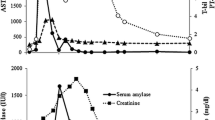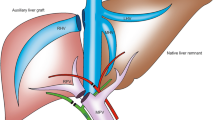Abstract
From 1975 to 1993, our University Hospital performed 2789 graft procedures. During the same period, 12 poisoned, “brain-dead” patients were considered as organ donors. The toxic substances involved were: methaqualone (n=1), benzodiazepine alone (n=1), benzodiazepine plus tribyclic antide-pressants (n=1), tricyclic antide-pressants alone (n=1), barbiturates (n=2), insulin (n=2), carbon monoxide (n=1), cyanide (n=1), methanol (n=1), and acetaminophen (n=1). From these intoxicated persons, 32 organ transplants were obtained, but only 23 could be followed for 1 month and only 20 for 1 year. The outcome at 1 month was favorable in 20 of the 23 patients. Two heart transplant patients died within 24 h after grafting from stroke and acute heart failure, respectively. Preoperative hepatic encephalopathy was not corrected after grafting and was directly responsible for the death of a liver transplant patient. After 1 year, 15 of the 20 recipients were still alive. Chronic hepatic graft rejection led to a fatal outcome in one recipient and to second grafting in amother. Finally, one recipient died from delayed neoplasia. Based on our experience, organ procurement may be considered in a few select cases of acute poisoning. Attention should, however, be drawn to possible graft damage due to some poisons.
Similar content being viewed by others
References
Bessoudo R, Gray J (1978) Carbon monoxide poisoning and nonoliguric acute renal failure. Can Med Assoc J 19: 41–44
Brown PWG, Buckels JAC, Jain AB, McMaster P (1987) Successful cadaveric renal transplantation from a donor who died of cyanide poisoning. BMJ 294: 1325
Cavalli A, Volpi A, Maggioni AP, Tusa M, De Pieri G (1987) Severe reversible cardiac failure associated with methanol intoxication. Postgrad Med J 63: 867–868
Dolan MC (1985) Carbon monoxide poisoning. Can Med Assoc J 133: 539–542
Graham DL, Laman D, Theodore J, Robin E (1977) Acute cyanide poisoning complicated by lactic acidosis and pulmonary oedema. Arch Intern Med 137: 1051–1055
Hantson PE, Squifflet JP, Vekemans MC, Evrard P, Hassoun A, Sepulchre MA, De Ceuninck P, Mahieu P (1991) Successful pancreas and renal transplantations from a donor who died of cyanide poisoning. Clin Transplant 5: 419–421
Hebert MJ, Boucher A, Beaucage C, Girard R, Dandavino R (1992) Transplantation of kidneys from a donor with carbon monoxide poisoning. N Engl J Med 326: 1571
Karwande SV, Hopfenbeck JA, Renlund DG, Burton NA, Gay WA (1989) The Utah Transplantation Program. An avoidable pitfall in donor selection for heart transplantation. J Heart Transplant 8: 422–424
Leikin JB, Heyn-Lamb R, Aks S, Erickson T (1993) The toxic patient as a potential organ donor: one year follow-up (abstract). Vet Hum Toxicol 35: 318
Lindqvist TD, Oiland D, Weber K (1988) Cyanide poisoning victims as corneal transplant donors. Am J Ophthalmol 106: 354–355
Price IM, Poklis A, Johnson DE (1991) Fatal acetaminophen poisoning with evidence of subendocardial necrosis of the heart. J Forensic Sci 36: 930–935
Riou B, Gerard JL, La Rochelle CD, Bourdon R, Berdeaux A, Giudicelli JF (1991) Hemodynamic effects of hydroxocobalamin in conscious dogs. Anesthesiology 74: 552–558
Rowe VK, McCollister SB (1982) Alcohols. In: Clayton GD, Clayton FE (eds) Patty's industrial hygiene and toxicology. John Wiley & Sons, New York, pp 4557–4708
Singh BM, Coles N, Lewis P, Braithwaite RA, Nathrass M, Fitzgerald MG (1989) The metabolic effects of fatal cyanide poisoning. Postgrad Med J 65: 923–925
Swanson-Biearman S, Krenzelok EP, Snyder JW, Unkle DW, Nathan HM, Yang S-L (1993) Successful donation and transplantation of multiple organs from a victim of cyanide poisoning. Clin Toxicol 31: 95–99
Vekemans MC, Hantson PE, Fievez P, Gautier PE, Squifflet JP, Sepulchre MA, Hassoun A, De Ceuninck P, Mahieu P (1990) Cyanide as a functional poison: possibility of organ donation after brain death. Proceedings of the International Toxicology, Poison Control and Analytical Toxicology Bulletin de la Société des Sciences Medicales du Grand — Duché de Luxembourg, LUX TOX 198, pp 198–201
Author information
Authors and Affiliations
About this article
Cite this article
Hantson, P., Vekemans, MC., Squifflet, JP. et al. Outcome following organ removal from poisoned donors: experience with 12 cases and a review of the literature. Transpl Int 8, 185–189 (1995). https://doi.org/10.1007/BF00336535
Received:
Revised:
Accepted:
Issue Date:
DOI: https://doi.org/10.1007/BF00336535




